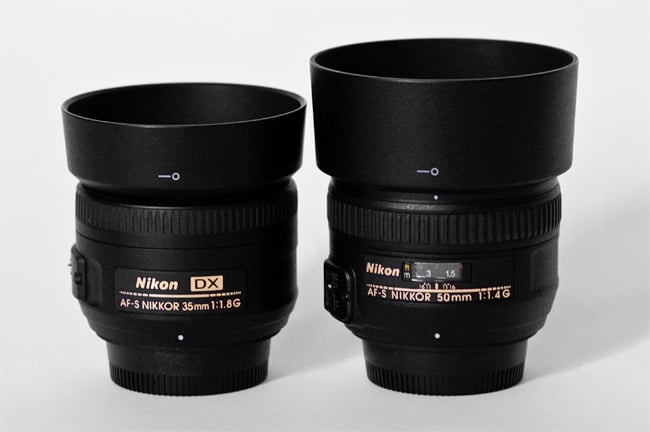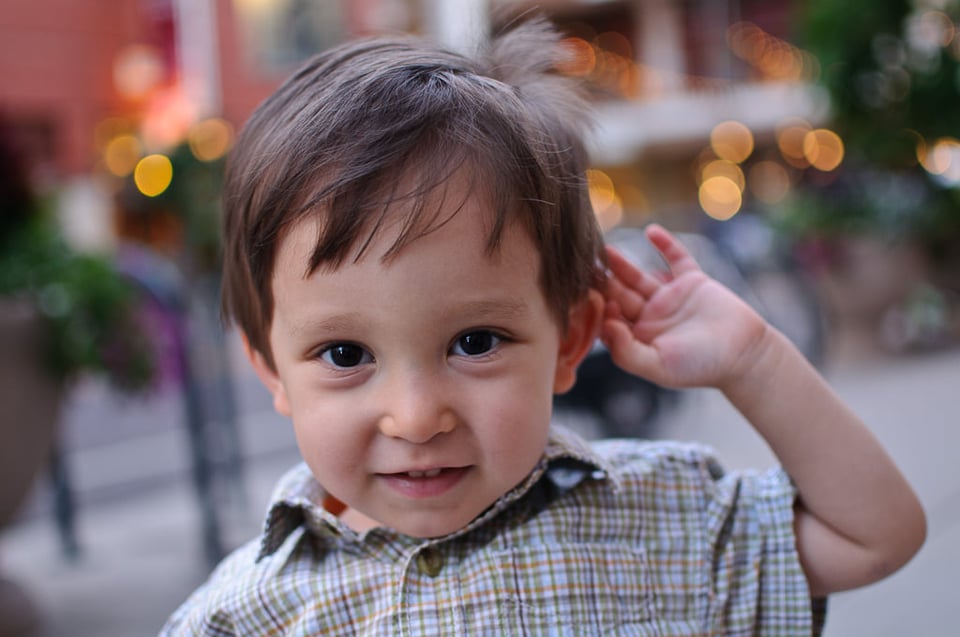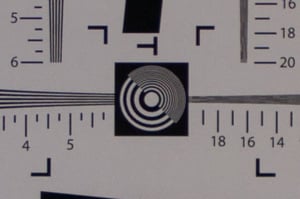Some of our readers, especially those who are just getting into photography, frequently ask me if they should choose the Nikon 35mm f/1.8G DX or Nikon 50mm f/1.4G to be used for low-light photography. I decided to run a quick comparison between the two, along with some other technical information to hopefully make it easier for our readers to select the right lens in this Nikon 35mm f/1.8 DX vs Nikon 50mm f/1.4 comparison.

Here is a quick summary of differences between the Nikon 35mm f/1.8G and Nikon 50mm f/1.4G:
- DX vs DX/FX – the first major difference I want to point out between the two, is the Nikon 35mm f/1.8G is a DX-only lens, which means that it will only properly work on DX sensor cameras like Nikon D3100/D5000/D90/D300s/D7000. The Nikon 50mm f/1.4G, on the other hand, works well on both DX and FX sensor cameras such as Nikon D700/D3s/D3x.
- Focal length – the second obvious difference is the focal length. The Nikon 35mm f/1.8G has an equivalent field of view of 52.5mm on a DX sensor, while the Nikon 50mm f/1.4G has an equivalent field of view of 75mm. Interestingly, both lenses fall into the “normal” or “standard” lens category, depending on the type of sensor they are mounted on. For example, on a DX sensor, the Nikon 35mm f/1.8G is a “normal” lens, while the Nikon 50mm f/1.4G is also “normal” on a full-frame sensor. However, if the Nikon 50mm f/1.4G is mounted on a DX sensor, it becomes a telephoto lens, since its field of view narrows to 75mm. If this sounds confusing to you, read my article on “Equivalent Focal Length and Field of View“.
- Maximum Aperture – the Nikon 35mm f/1.8G has a maximum aperture of f/1.8, while the Nikon 50mm f/1.4G has a maximum aperture of f/1.4. Both lenses are very fast, but the 50mm can pass through slightly more light than the 35mm lens.
- Minimum Aperture – the Nikon 35mm f/1.8G has a minimum aperture of f/22, while the Nikon 50mm f/1.4G has a minimum aperture of f/16. Note that the large minimum aperture of the 35mm lens is not very useful on a DX camera, since photographing at such small apertures will significantly degrade image quality due to diffraction.
- Closer focusing – the Nikon 35mm f/1.8G allows close focusing to just one foot, while the Nikon 50mm f/1.4G is at 1.5 feet.
- Filter size – the Nikon 35mm f/1.8G has a 52mm filter thread, while the 50mm has a 58mm thread for filters.
- Weight – the Nikon 35mm f/1.8G is about 80 grams lighter than the Nikon 50mm f/1.4G (200 grams vs 280 grams).
- Compactness – as you can see from the above image, the Nikon 35mm f/1.8G is smaller than the Nikon 50mm f/1.8G.
- Price – the Nikon 35mm f/1.8G is the second cheapest prime lens after 50mm f/1.8D that retails for around $200 (check current price), while the Nikon 50mm f/1.4G is more than twice as expensive, retailing for $435.
Many are probably interested in seeing how both compare against each other in terms of sharpness and bokeh. Let’s take a look at the sharpness comparison first.
Sharpness Comparison
I performed the below tests on a DX body (Nikon D90), because it would have been unfair to compare both on different sensors. To get to the same field of view on both lenses, I had to move the 50mm slightly away from the test target. The shooting conditions were exactly the same for both lenses. Let’s take a look at how both compare in terms of sharpness when shot at f/1.8 in the center (Left: Nikon 35mm f/1.8G, Right: Nikon 50mm f/1.4G):
The Nikon 35mm f/1.8G is an incredibly sharp lens wide open. As you can see, it performs better wide open than the 50mm f/1.4G stopped down to f/1.8. Let’s see what happens at f/2.8:
Although both look very similar, the Nikon 35mm f/1.8G still has a slight edge over the 50mm f/1.4G. What about f/4.0:
Now both look about the same.
I won’t bother showing samples from smaller apertures, because both lenses perform very similarly. Plus, there are very few situations where you would use very small apertures on portrait lenses…
Let’s see how well these lenses perform in the corners at f/1.8 (Left: Nikon 35mm f/1.8G, Right: Nikon 50mm f/1.4G):
Don’t pay much attention to corner performance – it is typically unimportant for portrait lenses, since you would rarely place your subjects in the corners. These are provided simply as a reference, to get an idea of how the lenses compare against each other in the corners. As you can see, both perform about the same, with no notable difference between the two. Let’s see what happens at f/4.0:
When stopped down, the Nikon 50mm f/1.4G clearly takes the lead – it is certainly sharper and has much less chromatic aberration.
The above is nothing new – Nikon’s published MTF for the Nikon 35mm f/1.8G clearly shows that it is supposed to be sharper than the Nikon 50mm f/1.4G when shot at the maximum aperture.
One thing you have to remember though, is that you should not only look at sharpness tests when choosing between lenses. Charts are not always 100% reliable due to their plain, 2D nature – a separate test with 3D objects would certainly help (going forward, I will be doing an additional “3D test” while reviewing lenses). There are plenty of other optical characteristics that need to be evaluated, such as vignetting, chromatic aberration, distortion, etc., which I will write about in upcoming lens reviews of the 35mm and 50mm lenses.
Bokeh Comparison
Another very important lens characteristic that you need to evaluate in a portrait lens is bokeh – the quality of out of focus areas in a picture. Lola and I both really love the way the Nikon 50mm f/1.4G renders bokeh – it is not top of the class like Nikon 85mm f/1.4G, but still very good for portraits. I have played with the Nikon 35mm f/1.8G quite a bit and found its bokeh to be pleasing to look at. Not as good as the 50mm, but still not bad at all. Take a look at the below photo of our son Ozzy, taken at f/2.0:

The background looks nice to me, I would say similar to the way 50mm f/1.8D renders it. When compared to the 50mm f/1.4G lens, the Nikon 35mm has 7 diaphragm blades, versus 9 on the 50mm f/1.4G. Those diaphragm blades do affect the shape of highlight circles and hence might appear a little less circular on the 35mm f/1.8G. Another thing to keep in mind is subject distance. Since the 35mm f/1.8G is a shorter lens, you would have to get much closer to your subject to get comparable bokeh.
Recommendations
So, which one of these lenses do I recommend? If you use a full-frame camera or primarily shoot portraits and need to get one of the best portrait lenses for under $500, I would certainly recommend the Nikon 50mm f/1.4G. For everything else, including day-to-day photography, I would say the Nikon 35mm f/1.8G is a better choice for DX cameras. Not only due to its focal length, but also its comparably good performance in terms of sharpness and bokeh. When it comes to focal lengths, while the Nikon 50mm f/1.4G is perfect on a full-frame FX camera, it certainly feels a little “too long” on a DX camera. Its narrower field of view on cropped sensors is quite limiting in terms of what you can fit into the frame, whereas the 35mm feels just perfect. We have used the Nikon 35mm f/1.8G for food, portrait and even landscape photography and I really liked working with this focal length. Take a look at this shot that I captured early in the morning in a state park:

I’m glad I used the 35mm f/1.8G lens for this shot, since a 50mm would have been too long to capture enough of the sky.
Last, but not least, is the price difference. I believe the Nikon 35mm f/1.8G is a great value, given that it only costs $200, more than twice less than the 50mm f/1.4G. Why didn’t I compare the Nikon 35mm f/1.8G with the older and cheaper Nikon 50mm f/1.8D? Because the latter does not autofocus on cheaper Nikon bodies like D5000.

A note to technical gurus and pros: I know that comparing lenses like I have done above is not fare due to many reasons such as different optics/focal lengths and etc. I only did it to make it easier for beginners to choose the right lens for their needs. The above information is only provided for DX sensors – it is impossible to compare both lenses on FX, since the 35mm f/1.8G only works at half the resolution on a full-frame body and is really not designed to be used on FX.










Very nice and easy make decision and to understand difference for a beginner who ownd d5300 apx. 9 years.just with 18-180. Today get 50 1.4. And tomorrow 35mm. So have to get both and get use to it.👍 does Dx 18-180 G fits FX?
Great article for novice photographers like me. Helped me decide which lens to buy.
Thank you for the information now i know what lens going to buy for my d7000…
Which lens is all rounder for potraits, landscape, street photography? Is there any difference (in terms of sharpness and smoothness) other than field of view?
It would be great having a comparison of the new Sigma Art 35mm 1.4 vs Nikon 50mm 1.4 or Sigma Art 50mm 1.4 vs Nikon 50mm 1.4 :)
Thanks a lot for the information Sir. As a beginner, I don’t know anything much about cameras and lenses. Your blog helped me a lot.
I have a question for you. I’m having Nikon D3500 with the kit lens and I took many photographs, none of which are sharp/perfect as I want. I’m also not able to shoot indoors with low light properly… Can you help me? I would like to know about the things I should do to produce sharp and good photos.
Anyways, thanks for this blog!
Thanks a lot. It definitely cleared a lot of doubts. Special appreciation for explaining with such a clarity of thought and in few words.
I have Nikon D5200 DSLR with Nikkor 18-55mm & Nikkor 18-200 VR II. I want to have a Fix Lens. Which one would be better? Nikkor 50 mm 1.8 or Nikkor 35mm 1.8?
recently bought a D5300 with DX sensor, your article helps me a lot for choosing my 1st lens aside from the kit provided.. thanks a lot! it saves me a lot of time.
Thanks!
Great blog. Detailed explanation. Thanks for sharing.
I am planning to visit spiti valley and made a purchase of my package from the following site :
www.journeytoexplore.com/tours…ti-valley/
I want to know that which lenses I should use for my trip any suggestion would be highly appreciated